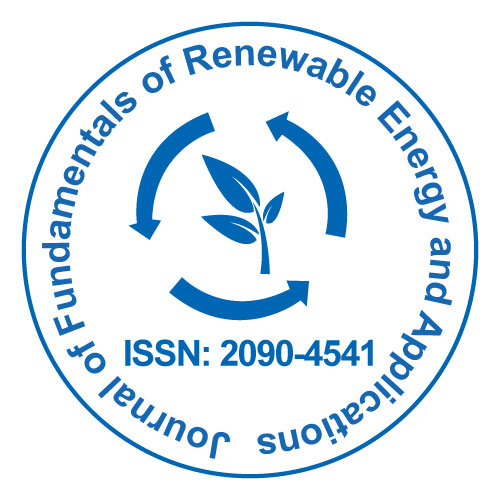
Journal of Fundamentals of Renewable Energy and Applications
Open Access
ISSN: 2090-4541
+44 1300 500008

ISSN: 2090-4541
+44 1300 500008
Opinion - (2023)Volume 13, Issue 2
A large structural change in an energy system affecting supply and consumption is known as an energy transition or energy system transformation. To slow down climate change, a move to sustainable energy, primarily renewable energy, is currently under place. Transition to renewable energy is another name for it. The driving reason behind the current transition is the realisation of the necessity of a considerable decrease in global greenhouse gas emissions. In this process, fossil fuels are gradually phased out and entire systems are rebuilt to run on low-carbon electricity. Before the current energy transition, coal, oil, and most recently natural gas displaced wood and other biomass throughout the industrial revolution.
The world's energy needs are met to an extent of 85% by burning fossil fuels as of 2019. 76% of every year's emissions of greenhouse gases were attributed to the consumption and production of energy as of 2018. The 2015 Paris Climate Agreement's objectives must be met by reducing emissions as soon as possible and achieving net-zero emissions by the middle of the century. Since the late 2010s, when the solar and wind industries' efficiency increased rapidly, there has been a shift towards renewable energy. The reduction of additional environmental effects caused by the energy sector is another reason for the switch.
An increase in public transportation, a reduction in air travel, and the use of electric vehicles are all part of the transition to renewable energy. Heat pumps are by far the most effective heating technology now being used in buildings. Energy storage and super grids are essential to allow for variable, weatherdependent technologies in order to increase the electrical grid's scale flexibility.
In a time when the effects of climate change are becoming increasingly visible and the need for energy is rising to new levels, the idea of an energy transition has emerged as a source of comfort. This change from standard fossil fuels to more environmentally responsible and sustainable energy sources is not just a trend; it is absolutely necessary for the survival of the planet and the well-being of future generations.
The reasons for embracing the energy transition are manifold and compelling. The combustion of fossil fuels has, first and leading , caused a hazardous buildup of greenhouse gases in the atmosphere, accelerating global warming and causing extreme weather conditions, rising sea levels, and ecosystem changes. They can greatly reduce carbon emissions and lessen the worst effects of climate change by shifting towards renewable energy sources like solar, wind, hydro, and geothermal power.
Furthermore, the energy transition offers remarkable economic opportunities. As traditional energy industries face volatility and depletion, transitioning to renewables can stimulate economic growth and diversify energy markets. This shift not only secures an energy independence but also fosters technological advancement, attracting forward-thinking industries that will drive progress in the 21st century.
Concerns regarding the upfront expenditures of converting infrastructure and the limited availability of renewable energy sources are frequently voiced by opponents of the energy transition. These challenges can be overcome, though. The effectiveness, dependability, and affordability of renewable technologies are continuously improving because of technological developments. In order to overcome the issue of intermittency and guarantee a steady supply of electricity even when the sun isn't shining or the wind isn't blowing, smart grids, enhanced energy management systems, and battery storage are being used.
Besides, the transition to renewable energy can enhance energy security by reducing a reliance on geopolitically volatile fossil fuel sources. Nations can gain greater control over their energy resources and reduce the vulnerability associated with energy supply disruptions, ultimately strengthening their national security. In the effort to promote the energy transition, it's essential to acknowledge that it's not just a matter of replacing one energy source with another. It's about fundamentally reshaping a relationship with energy, embracing conservation and efficiency, and creating a more sustainable lifestyle. Individuals, governments, and businesses all have roles to play in this transformation, from adopting energy-efficient technologies to supporting policies that incentivize clean energy adoption. The energy transition represents a pivotal moment in human history —a chance to recalibrate an energy systems and chart a course towards a sustainable, resilient future. The urgency of addressing climate change, the economic potential of renewable energy, and the need for energy security all converge in support of this transition. While challenges undoubtedly lie ahead, the benefits far outweigh the costs, and the pursuit of a cleaner, greener energy landscape is not only wise but essential for the prosperity and survival of a planet.
Citation: Varma P (2023) Understanding the Global Energy Transition for a Sustainable World. J Fundam Renewable Energy Appl.13:313.
Received: 11-May-2023, Manuscript No. JFRA-23-26196; Editor assigned: 15-May-2023, Pre QC No. JFRA-23-26196 (PQ); Reviewed: 29-May-2023, QC No. JFRA-23-26196; Revised: 05-Jun-2023, Manuscript No. JFRA-23-26196 (R); Published: 12-Jun-2023 , DOI: 10.35248/2090-4541.23.13.313
Copyright: © 2023 Varma P. This is an open-access article distributed under the terms of the Creative Commons Attribution License, which permits unrestricted use, distribution, and reproduction in any medium, provided the original author and source are credited.